golden gate bridge
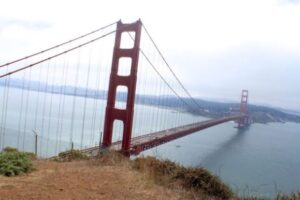
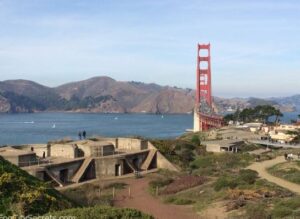 Battery Spencer was a reinforced concrete Endicott Period 12-inch gun battery, which was located on Fort Baker, Lime Point, Marin County, California. The structure still exists today and is a favorite tourist attraction. The battery was named on Feb 14, 1902, after Major General Joseph Spencer, who was a Revolutionary War hero. Spencer died on January 13, 1789. Construction on the battery began in 1893, and it was completed in 1897. Following its completion, it was transferred to the Coast Artillery for use on September 24, 1897, at a total cost of $110,352.70. It was deactivated in 1942 during World War II.
Battery Spencer was a reinforced concrete Endicott Period 12-inch gun battery, which was located on Fort Baker, Lime Point, Marin County, California. The structure still exists today and is a favorite tourist attraction. The battery was named on Feb 14, 1902, after Major General Joseph Spencer, who was a Revolutionary War hero. Spencer died on January 13, 1789. Construction on the battery began in 1893, and it was completed in 1897. Following its completion, it was transferred to the Coast Artillery for use on September 24, 1897, at a total cost of $110,352.70. It was deactivated in 1942 during World War II.
The battery was originally part of the Harbor Defense of San Francisco. The harbor was likely one of the most vulnerable entrances to San Fransisco, and in the early days of the country, when radar didn’t exist, it was hard to tell if an enemy was sneaking into the harbor, especially a submarine. Battery Spencer was a concrete coastal gun battery with three M1888 12-inch guns mounted on long range Barbette M1892 carriages. It was constructed on top of the five front emplacements of Battery Ridge. Back in the early 1900s, Battery Spencer was one of the main protection points for the San Francisco Bay. It featured multiple lookout points that were operated by the military and a few buildings for housing the generators and shells. It was used on and off until World War II when a lot of it was scrapped for war efforts.
The guns were mounted on 3 emplacements. Emplacements #1 and #2 were separated by a magazine with two shell rooms, a powder room, and a shell hoist room. Emplacement #3 had its own shell room, powder room, and hoist room. Spencer Battery was a two-story battery with the magazines on the lower level and the gun emplacements on the upper level. The missiles, or more likely cannon balls at first, were originally moved from the magazine level to the loading level with hand powered projectile hoists. In 1908, the hand powered hoists were replaced with electric Taylor-Raymond front delivery hoists. The new hoists were put into service on September 30, 1908. There were no powder hoists at Battery Spencer, meaning that gun powder had to be moved by hand.
Along the access road that runs north of Emplacement #1, was the BC Post and a separate building that had four rooms. The rooms consisted of a CO room, a guard room, an oil room, and a large 12′ by 43′ plotting room. All of these were used to plan any defensive action taken by the soldiers stationed at Battery Spencer. Two other buildings across the road completed the battery. One housed the tools and rammers, the other a latrine building with separate facilities for officers and enlisted. In 1910 the BC post and the plotting room were remodeled and updated. The work was accepted for service on August 5, 1910, at a cost of $1680.68.
When the United States entered World War I, it was decided that the large caliber coastal defense gun tubes should be removed from coastal batteries and sent into service in Europe. First, they were sent to arsenals for modification and mounting on mobile carriages, both wheeled and railroad. Strangely, most of the removed gun tubes never made it to Europe. Many were either remounted at the batteries or remained at the arsenals until needed elsewhere. One gun was removed from Battery Spencer emplacement #3 in 1918 and sent to Battery Chester at Fort Miley. The gun at Battery Spencer was never replaced, and the emplacement was considered abandoned. The carriage remained in place until it was ordered salvaged on January 10, 1927. World War II brought the first large scale scrap drive, and the remaining two guns and carriages were ordered scrapped on November 19, 1942. 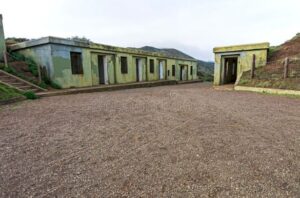
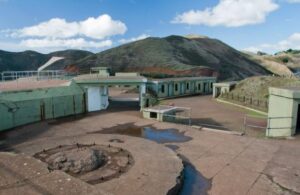
These days Battery Spencer is part of the Golden Gate Recreation Area (GGNRA) administered by the National Park Service. It is a favorite historical attraction, even though no period guns or carriages are in place. The site is also one of the very best views of the Golden Gate Bridge and San Francisco.
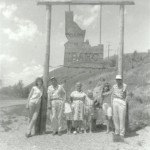
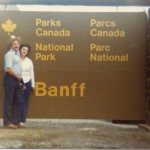 Lots of people do it, but some people don’t. What…you might ask. The answer is to photograph the family whenever they cross the border into a new state, country, or sometimes even county. When my sisters and I were kids, our parents took us on vacation every year. We were quite blessed in that way, and have been to almost all the states, as well as Canada and Mexico, with some of us traveling even further away than that. All through those years, one of the big memories is the Border Crossings. I’m sure many people might think that sounds silly, but it was proof that was had been in that place. Anyone can say they have been to many places around the world, but if you have no pictures to prove it, how do people know that you aren’t just a braggart.
Lots of people do it, but some people don’t. What…you might ask. The answer is to photograph the family whenever they cross the border into a new state, country, or sometimes even county. When my sisters and I were kids, our parents took us on vacation every year. We were quite blessed in that way, and have been to almost all the states, as well as Canada and Mexico, with some of us traveling even further away than that. All through those years, one of the big memories is the Border Crossings. I’m sure many people might think that sounds silly, but it was proof that was had been in that place. Anyone can say they have been to many places around the world, but if you have no pictures to prove it, how do people know that you aren’t just a braggart.
For me it is about owning that place, I suppose. It’s not that I purchased land in every place I’ve been, but rather that each place that have put my feet on the ground in has been permanently fixed in my memory files. I have those pictures and many others in my memory to remind me of the great trip we took to this or that place. I carry those pictures in my memory files, just like my Kindle carries the assorted books I have purchased in its memory files. The items stored there can be accessed at a moment’s notice. I can see the 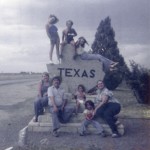
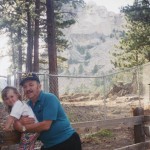 area, remember the sights we saw, remember who we were with, and the wonderful time we had there. Those memories are mine forever.
area, remember the sights we saw, remember who we were with, and the wonderful time we had there. Those memories are mine forever.
There are many kinds of border crossings, both good and bad, but the ones I choose to carry with me are the crossings from state to state as we wandered across this great nation. If you haven’t traveled much you just can’t understand how amazing this country is. There is beauty from coast to coast. So many people think that only their dream location has beauty, but that is so untrue. Every place on this Earth has some form of beauty. We must simply look for it. I feel so blessed to have been given the opportunity to see so many places, and discover the beauty in each one. Our parents wanted that for their girls. They were those people who would drive miles out of their way to see this or that historical site, and because of their willingness, and the fact that they considered each place important, my sisters and I can say that we have seen things like the Oregon Trail, old West Jailhouses, wagon ruts in rocks made by years of wheels going across them chipping away grain after grain of the rock, and canyons carved in rocks by rivers that have wandered through there for centuries. We have seen a crater formed by a meteor, a lake formed by an earthquake, and mountains formed by volcanoes. We have seen the Atlantic and Pacific Oceans, and the Gulf of Mexico, as well as the Great Lakes, and the Great 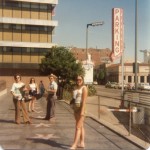
 Salt Lake. We have seen the Statue of Liberty, the Empire State building, and the World Trade Center. We have seen the faces of the Presidents on Mount Rushmore, Crazy Horse Monument, ridden the 1880 Train, and some of us have hiked much of the Black Hills, including Harney Peak. We have seen the Golden Gate Bridge, Fisherman’s Warf, and Alcatraz, as well as The Space Needle, many lighthouses, and countless beaches. So many places fill my memory files, and they all started with the first border crossing, as we left home on one of our wonderful family vacations.
Salt Lake. We have seen the Statue of Liberty, the Empire State building, and the World Trade Center. We have seen the faces of the Presidents on Mount Rushmore, Crazy Horse Monument, ridden the 1880 Train, and some of us have hiked much of the Black Hills, including Harney Peak. We have seen the Golden Gate Bridge, Fisherman’s Warf, and Alcatraz, as well as The Space Needle, many lighthouses, and countless beaches. So many places fill my memory files, and they all started with the first border crossing, as we left home on one of our wonderful family vacations.
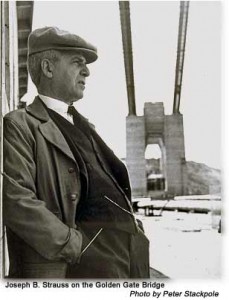 Some challenges are tougher than others, and the challenge to connect San Francisco with Marin County, California rates right up there among the most difficult…at least in 1937. I’m sure there have been bigger challenges since then and even before then, but I think that building what was the longest suspension bridge in the world in 1937 had to be really difficult. The bridge, which was built between January 1933 and May 1937, was to be 4,200 feet long. Its location was probably the biggest challenge the builders faced. The bridge is very close to the San Andreas Fault, which runs north and south directly through the San Francisco area. The bridge had to be built in such a way as to ensure its stability in the event of an earthquake. While earthquakes can happen anywhere in the world, it is such a strange idea to me to build something that depends on solid ground, on a known fault. Nevertheless, the bridge still stands today, and there have been many earthquakes in that area.
Some challenges are tougher than others, and the challenge to connect San Francisco with Marin County, California rates right up there among the most difficult…at least in 1937. I’m sure there have been bigger challenges since then and even before then, but I think that building what was the longest suspension bridge in the world in 1937 had to be really difficult. The bridge, which was built between January 1933 and May 1937, was to be 4,200 feet long. Its location was probably the biggest challenge the builders faced. The bridge is very close to the San Andreas Fault, which runs north and south directly through the San Francisco area. The bridge had to be built in such a way as to ensure its stability in the event of an earthquake. While earthquakes can happen anywhere in the world, it is such a strange idea to me to build something that depends on solid ground, on a known fault. Nevertheless, the bridge still stands today, and there have been many earthquakes in that area.
The second challenge the builders faced was the tumultuous waters the bridge had to span. The dangers that presented for the underwater construction were grave. The construction teams started their work on the peninsulas, building out over the wind-whipped waters of the San Francisco Bay. With labor and 70,000 tons of steel, they built arms that reached out to each other over the straits, getting closer by the day. Given the strait’s precarious mixture of violent winds, swirling currents, and thick fogs, many thought such a bridge couldn’t be built. Nevertheless, the builders have prevailed against the challenges they faced, because the bridge was completed successfully. In all, eleven men would lose their lives during construction, ten of them on February 17, 1937 when a section of scaffold carrying twelve men fell through the safety net.
I think the biggest challenge, that did not involve the elements, was a city who was skeptical and many people who were simply against a bridge across the San Francisco Bay. Nevertheless, Joseph Strauss, the engineer fought for 16 years to convince the people that the bridge was an amazing idea. He was a very proud man when he, on opening day, triumphantly exclaimed, “The bridge which could not and should not be built, which the War Department would not permit, which the rocky foundation of the pier base would not support, which would have no traffic to justify it, which would ruin the beauty of the Golden Gate, which could not be completed within my costs estimate of $27,165,000, stands before you in all its majestic splendor, in complete 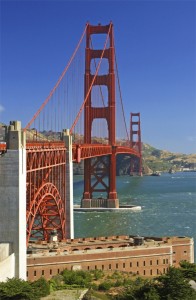 refutation of every attack made upon it.”
refutation of every attack made upon it.”
And so it was that the seemingly impossible was accomplished. The bridge was set to open on May 27, 1937, and by 6:00am, 18,000 people were lined up on both the San Francisco and the Marin county sides. In all, about 200,000 people showed up that day. At the appointed hour, a foghorn blew, and the toll gates opened. The earliest arrivals would have the distinction of being among the first to cross. Many offices, schools, and stores closed to attend the great event. The day was designated Pedestrian Day. The next day, he bridge opened to vehicle traffic. President Franklin Delano Roosevelt proclaimed the bridge open to the world. By the end of that day, 32,000 vehicles had paid the tolls and crossed the historic bridge. In the 70 plus years it has been open, it is estimated that nearly 2 billion vehicles have crossed the bridge. The Golden Gate Bridge and the views it holds are beautiful, and I am happy to have been one of those people to have crossed it.
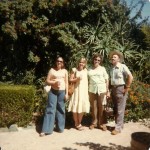
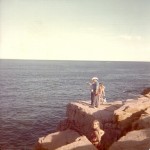 In 1980, my parents and younger sisters took a trip to California. It was a trip that would take them to the famous Golden Gate Bridge, as well as, drives along the Pacific Ocean, and relaxing time spent on the beach. It was the first of a number of trips my parents would take to California. They really loved that area. I would not get to see California until the late 1990s. I’m not sure what took me so long really.
In 1980, my parents and younger sisters took a trip to California. It was a trip that would take them to the famous Golden Gate Bridge, as well as, drives along the Pacific Ocean, and relaxing time spent on the beach. It was the first of a number of trips my parents would take to California. They really loved that area. I would not get to see California until the late 1990s. I’m not sure what took me so long really.
Today is a rather significant day in the history of San Francisco, and one that in reality makes any trip to California worth taking. It was on this day January 5, 1933 that work began on the rather controversial Golden Gate Bridge. I’m sure that most people would not think of the bridge as being controversial, but there were a lot of people who were against it because they thought it would ruin the beautiful view of the San Francisco Bay. I guess I can understand that to a degree, because I am someone who really doesn’t like change much, but when you look at the finished product, I would have to agree with most people when I say that I think this one was a good change. The bridge is a beautiful addition to the bay. I especially like its red color, which I suppose might seem a bit unusual for a bridge. Nevertheless, it does make this bridge stand out.
Still, why was the bridge necessary? When you look at the whole area, you find that you could have driven around the area. Nevertheless, I’m sure that back then, driving around would take too long. The idea was that if the land north of the bay was easier to access, it’s value would increase. It made sense, but while the idea was first presented in 1869, it was pretty much tabled until it was revisited in 1916, when a former engineering student named James Wilkins, who was working for the San Francisco Bulletin brought it up again. He proposed a suspension bridge with a center span of 3,000 feet which was nearly twice as long as any bridge in existence at the time. The expected cost was $100 million, but when the city engineer, Michael O’Shaughnessy, who is also credited for naming the Golden Gate Bridge began to ask around, he found Joseph Strauss, a 5 foot tall Cincinnati born Chicagoan who said he could do it for less. In fact, for $25 – 30 million, Strauss said he could build one with a 4,000 foot span.
The idea was well received, but the Great Depression would stall the construction until 1933 when bonds could be sold to make it happen. The bridge would take four years to complete, and so it first opened on May 27, 1937, as the longest bridge span in the world 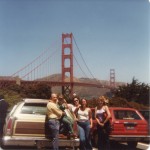
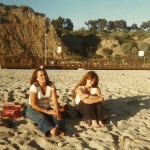 at that time. The first public crossing had taken place the day before, when 200,000 people walked, ran, and even roller skated across the bridge. It’s red paint job and its famous towers have made the Golden Gate Bridge an American landmark and popular tourist attraction ever since, and one that I am glad I got to see. While San Francisco’s temperatures don’t always appeal to me, the summers of which are not always warm, I do nevertheless, love visiting there. Like my parents, I find the California coast to be a pleasant change from the mountains of Wyoming.
at that time. The first public crossing had taken place the day before, when 200,000 people walked, ran, and even roller skated across the bridge. It’s red paint job and its famous towers have made the Golden Gate Bridge an American landmark and popular tourist attraction ever since, and one that I am glad I got to see. While San Francisco’s temperatures don’t always appeal to me, the summers of which are not always warm, I do nevertheless, love visiting there. Like my parents, I find the California coast to be a pleasant change from the mountains of Wyoming.

